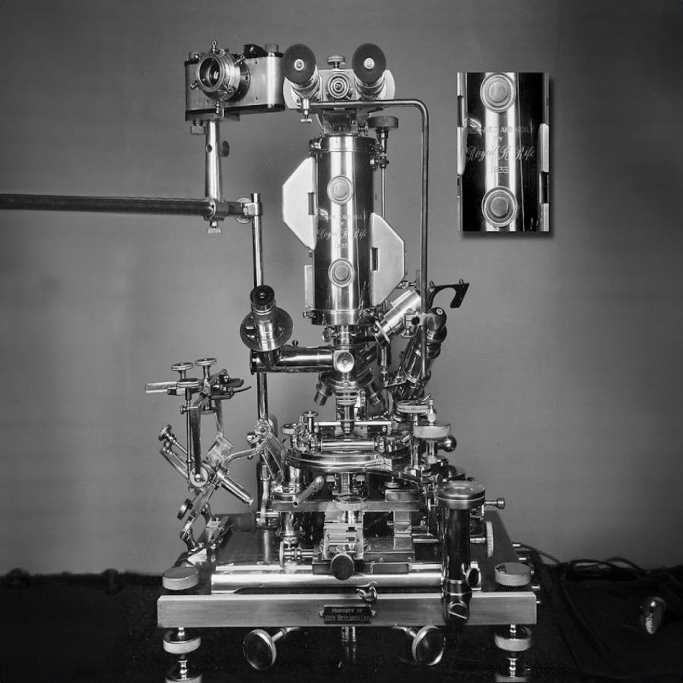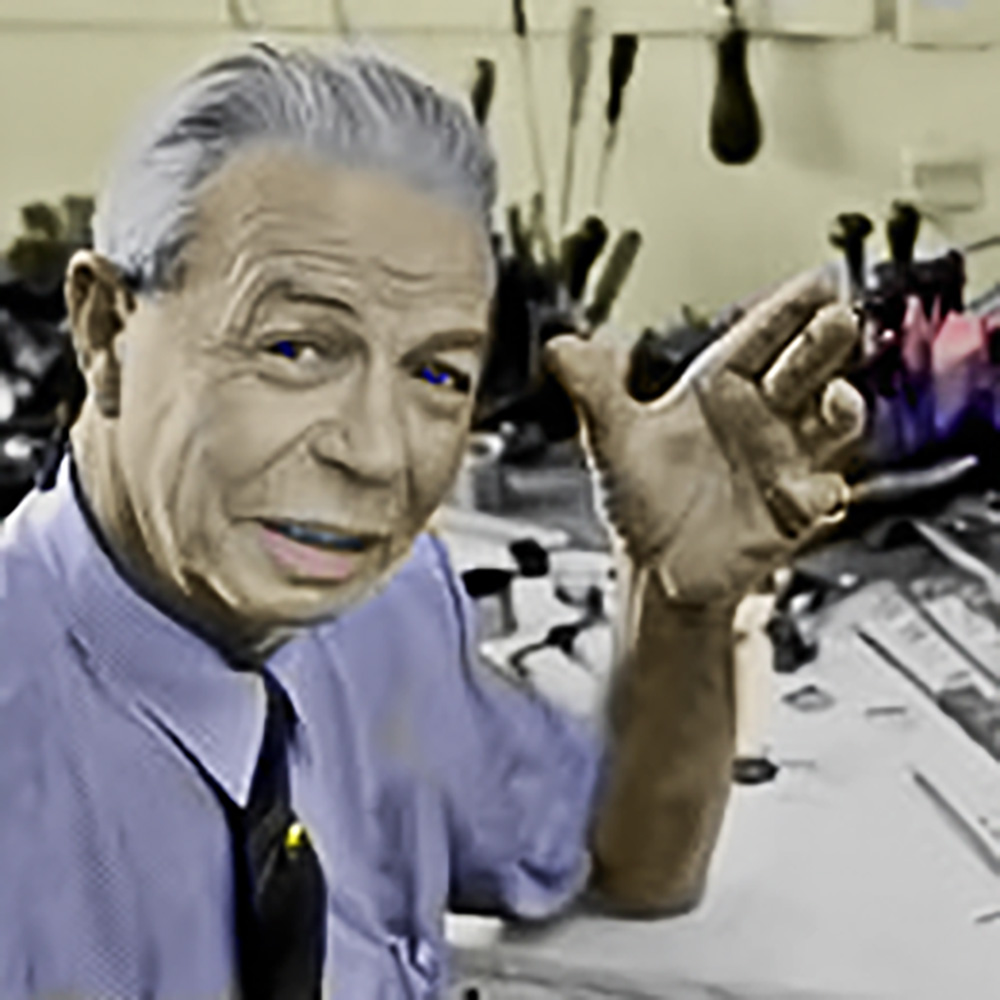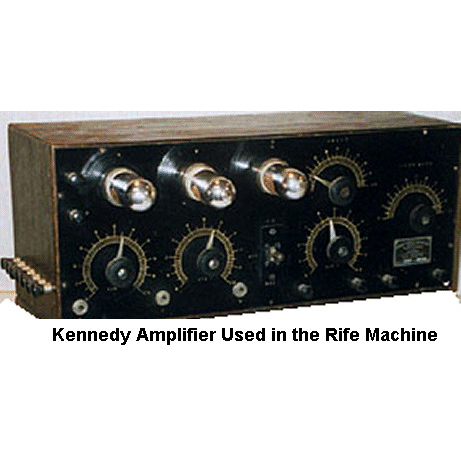
The greatest mistake in the long ordeal of the 1930s probably happened on May 3-4, 1932 when Kendall addressed the Association of American Physicians in Baltimore. Sitting in the audience waiting to pounce were Dr. Rivers and Dr. Zinsser. Neither had been able to reproduce the effects which Kendall showed were possible using his “K Medium”. But potential allies also were in that audience such as the great William Welch. Kendall had a right to be proud of his achievement, but it was a catastrophic error in judgment for him to ignore the Rife microscope in his talk and especially in his defense after Rivers and Zinsser had essentially called him a liar.
Kendall had already published with Rife a description of their combined achievement. All he had to do was simply state that a great new microscope made the filter-passing forms visible to the eye. Without access to the microscope, Rivers and Zinsser had no argument. But Kendall did not mention Rife. If he had, all the researchers who would later read the description of the meeting (in the Journal of the AMA for the summer of 1932) would have focused on the microscope instead of the monomorphism versus pleomorphism feud.
Royal Rife’s Microscope
Publishing the discovery in the Journal of the AMA in 1932-long before Rife became a threat to the AMA-might have changed the history of later years. If nothing else the microscope’s abilities would have been more widely known and Rife’s authority would have been harder to attack seven years later when it was his cancer curing instrument: The Royal Rife Machine which was the subject of litigation. But Kendall tried to gain too much glory for himself…. “I think Kendall was paid off about $200,000. He went down deep into Mexico and he bought a ranch to that tune, and the Mexicans cleaned him out of that. So he is living off his son-in-law in La Jolla.” (1958). Kendall died the following year in the town where the 1934 clinic had cured cancer. There was something odd-even mystically – about the way in which people associated with the cancer treatment found their way to La Jolla, as will be seen when the later story of Dr. Virginia Livingston-Wheeler is summarized.
Even with Kendall’s silence in Baltimore, the opportunity for American microbiologists to put aside the silly monomorphism versus pleomorphism debate and focus on what the microscope showed, was still there. Yet few chose to do so. Rosenow’s two reports in the summer of 1932-one in the Mayo Clinic’s publication and the other in Science magazine clearly provided the crucial facts to the scientific community. From Rosenow’s Science article of August 26, 1932: became the object of brutal attack when he had at his disposal a weapon which could have quickly silenced his opponents’ offensive. Kendall himself later came under the heavier guns which were employed in the 1940s to wipe out the memory of the “Examination under the Rife microscope of specimens, containing objects visible with the ordinary microscope, leaves no doubt of the accurate visualization of objects or particulate matter by direct observation at the extremely high magnification (calculated to 8,000 diameters) obtained with this instrument.” cancer treatment.
Kendall was an authority whose “K Medium” was crucial to Rife’s discoveries. Ben Cullen’s memories include this sad conclusion to Kendall’s brilliant career: Other scientists simply wouldn’t look. As Dr. Gruner’s 1939 letter made clear, the microscope authorities did not want to believe such a microscope existed. The old “light frequency” argument came up and still can be heard when rnicroscopists and physicists are told about the Rife microscope in the mid-1980s. Rife’s microscope contradicted the most cherished beliefs of the experts-then and now.
When the electron microscope began to be introduced in 1940-41, Rife made a trip to Germany. He recognized immediately that it was inferior to what he had built in 1929. His microscope could see living organisms. The electron microscope killed its specimens. As one expert in 1986 noted in discussing this “live” micro-organism versus “dead” micro-organism matter, the existing authorities will have to learn to “see” all over again. A generation of scientists have grown up on the electron microscope. The world of living micro-organisms is totally alien to them. It need not have been if Rife’s microscope and the Royal Rife Machine weren’t suppressed by ignorant men in control of power and resources beyond any kind of public accountability.
One can only imagine what could have evolved from Rife’s two great discoveries if a generation of scientists had been allowed to develop and improve them while gaining new knowledge of deadly micro-organisms and how their painless destruction extended human well-being. In 1938, Rife made his most public announcement. In a two part article written by Newall Jones of the San Diego Evening Tribune (May 6 and May 1 I), Rife said, “We do not wish at this time to claim that we have ‘cured’ cancer, or any other disease, for that matter. But we can say that these waves, or this ray, as the frequencies might be called, have been shown to possess the power of devitalizing disease organisms, of ‘killing’ them, when tuned to an exact wave length, or frequency, for each different organism. This applies to the organisms both in their free state and, with certain exceptions, when they are in living tissues.”
In 1953, Rife was not so conservative. In his copyrighted explanation of his work and discoveries, he states 14 of 16 cases of cancer and other diseases were cured in 1934 when the BX cancer frequency was turned on them for three minutes every third day. (The other two were pronounced cured one month after the clinic closed.) In 1942, four years after the San Diego news report, Dr. Raymond E. Seidel began investigating the microscope for an article. At one point, he spent 3 weeks in Rife’s Laboratory. In February 1944, the article appeared in the Journal of the Franklin Institute. It was reprinted later that year in the Annual Report of the Smithsonian Institution. Because Seidel was a medical doctor and not a microscope expert, his description was not in the technical terminology to which narrow minded microscope authorities were accustomed.
Dr. Seidel mentioned the 5,682 parts of the Universal Microscope and then described how it differed from ordinary microscopes: “Between the source of light and the specimen are subtended two circular, wedge-shaped, block crystal quartz prisms for the purpose of polarizing the light passing through the specimen, polarization being the practical application of the theory that light waves vibrate in all planes perpendicular to the direction in which they are propagated.
Therefore, when light comes into contact with a polarizing prism, it is divided or split into two beams, one of which is refracted to such an extent that it is reflected to the side of the prism without, of course, passing through the prism while the second ray, bent considerably less, is thus enabled to pass through the prism to illuminate the specimen. . . . Now, when the portion of the spectrum is reached in which both the organism and the color band vibrate in exact accord, one with the other, a definite characteristic spectrum is emitted by the organism. . . . ”
Now, instead of the light rays starting up the tube in a parallel fashion, tending to converge as they rise higher and finally crossing each other, arriving at the ocular separated by considerable distance as would be the case with an ordinary microscope, in the universal tube the rays also start their rise parallel to each other but, just as they are about to cross, a specially designed quartz prism is inserted which serves to pull them out parallel again, another prism being inserted each time the rays are about to cross. Thus, the greatest distance that the image in the universal is projected through any one media, either quartz or air, is 30 millimetres instead of the 160, 180, or 190 millimetres as in the empty or air-filled tube of an ordinary microscope. . . . ”
Under the universal microscope disease organisms such as those of tuberculosis, cancer, sarcoma, streptococcus, typhoid, staphylococcus, leprosy, hoof and mouth disease, and others may be observed to succumb when exposed to certain lethal frequencies peculiar to each individual organism, and directed upon them by rays covering a wide range of waves. By means of a camera attachment and a motion-picture camera not built into the instrument, many ‘still’ micrographs as well as hundreds of feet of motion-picture film bear witness to the complete life cycles of numerous organisms.
It should be emphasized, perhaps, that invariably the same organisms refract the same colors when stained by means of the monochromatic beam of illumination on the universal microscope, regardless of the media upon which they are grown. The virus of the Bacillus typhosus is always a turquoise blue, the Bacillus coli always mahogany colored, the Mycobacteria leprae always a ruby shade, the filter-passing form or virus of tuberculosis is always an emerald green, the virus of cancer always a purplish red, and so on.” Rife’s copyrighted explanation of 1953 describes the Universal Microscope’s unique design as follows: “The prime reason that viruses have never been observed in their true form of their association with a disease is because the best standard research microscopes will not show them; first, on account of the lack of great enough magnification and second, owing to the minuteness of these particles, it is impossible to stain them with any known method or technique using acid or aniline dye stains hence a substitute stain was found.
The viruses were stained with a frequency of light that coordinates with the chemical constituents of the particle or micro organism under observation. “The variation of the light frequency is accomplished by use of a variable monochromatic beam of light that is tuned to coordinate with the chemical constituents of particle, virus, or micro-organism. Visibility of the particle, virus, or micro organism is observed by use of the core beams from the patented Rife Microscope Lamps, which provide illumination through a series of rotating quartz prisms in the universal microscope and thence through the slide containing the specimens and on to the eyepiece. Rotation of the light beams in the quartz prisms controls the increase or decrease of the light frequency. With complete control of the illuminating unit, a frequency is created that is in coordination with the chemical constituents of the virus under observation and thus it is possible to observe the virus in its true chemical refractive index. The control of the illumination (in the universal microscope) is a most important factor in visualizing the virus of any pathogenic micro-organism. This cannot be accomplished by any conventional source of illumination.
This points out why other research groups have failed to find cancer virus.” The Royal Rife Machine’s were steadily improved from the early version of 1920 to the clinical versions of 1934-38 and then, in the 1950s, improved again to the point where Rife could assert, “they are infallible and simple to operate.”
The May 6, 1928 Evening Tribune of San Diego described what the Royal Rife Machine did: “Just what this Rife Machine does to the organisms to devitalize them is not yet known. Because each organism requires a different wave length, it may be that whatever befalls these tiny slayers of man is something similar to the phenomenon occurring when the musical tuning fork is set in vibration by sound waves emanating from another fork struck nearby. . . . ”
Rife thinks that the lethal frequencies for various disease organisms are, as in the sound waves, coordinates of frequencies existing in the organism themselves. If this is the explanation, it means that the Rife Ray probably causes the disease organisms to disintegrate or partially disintegrate, just as the vase and the glass. Several bits of evidence indicate that this is exactly what happens. . . . “When the ray is directed upon them, they are seen to behave very curiously; some kinds do literally disintegrate, and others writhe as if in agony and finally gather together in deathly unmoving clusters. “Brief exposure to the tuned frequencies, Rife commented, brings the fatal reactions. In some organisms, it happens in seconds. “After the organisms have been bombarded, the laboratory reports show, they are dead. They have become devitalized no longer exhibit life, do not propagate their kind and produce no disease when introduced into the bodies of experimental animals.
Rife recorded the mortal oscillatory rates for many organisms and the Rife Machine could be tuned to a germ’s recorded frequency and turned upon that organism with the assurance that the organism will be killed.” In 1950, after an absence of four years, including two years in an alcohol rehabilitation “prison” from which he finally escaped, Rife returned to his great work. In 1953, his cancer report was published-History of the Development of a Successful Treatment for Cancer and Other Virus, Bacteria a n d Fungi. Three years later, in 1956, he wrote a letter describing the safety of the Royal Rife Machine and also its advanced development: “I have operated the ‘Royal Rife Machine’ since 1921. I have watched it advance in style and performance with the advancement of electronics. “In the many years I used this equipment in my research, I have never suffered an injury or any ill effects whatsoever. I found it reliable in performance and efficient in results. The most recent model is infallible and simple to operate.”



